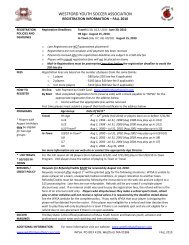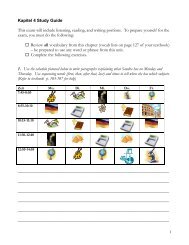Elizabethan Accessories and Hair Styles Women's Dress
Elizabethan Accessories and Hair Styles Women's Dress
Elizabethan Accessories and Hair Styles Women's Dress
Create successful ePaper yourself
Turn your PDF publications into a flip-book with our unique Google optimized e-Paper software.
<strong>Elizabethan</strong> Acoessories <strong>and</strong> <strong>Hair</strong> <strong>Styles</strong><br />
Defunked website= http://angelfire.com/nj3/kimmybot/<strong>Accessories</strong>.html<br />
Email: supastar88O5@aol.com<br />
<strong>Elizabethan</strong> <strong>Accessories</strong> <strong>and</strong> <strong>Hair</strong> <strong>Styles</strong><br />
Jewelry was an important accessory for both men <strong>and</strong> women. Men wore pendants attached to<br />
cord or chains, or lockets around their necks. Women, on the other h<strong>and</strong>, wore necklaces,<br />
enameled jewelry, pearls, semiprecious stones, rings, chains, earrings, bracelets, broaches, beads<br />
(eight or nine strings that hung down to the waist). Their necklaces were short or hip length.<br />
Bracelets were made of rope or beads. Real flowers or jeweled insects were worn to decorate the<br />
ruff.<br />
Gloves were an important, but an expensive accessory. They were embroidered on the backs<br />
<strong>and</strong> had cuffs with silk tassels. Often they were perfumed. Men also wore gloves.<br />
Women sometimes would wear veils. They were large <strong>and</strong> transparent. Sometimes it would be<br />
weird around the shoulders to form butterfly wings. Some women would place a corner over the<br />
forehead to make a small cap. The rest of the veil fell to the ground.<br />
Men’s shoes were made of leather, <strong>and</strong> had stockings that matched. A wedge shaped sole <strong>and</strong><br />
toe piece were one popular style. Later a pointed toe, low heel, <strong>and</strong> a cut out top became popular.<br />
Women’s shoes were like men’s.<br />
Hats were also common accessories. They were stiff <strong>and</strong> formal. They were often decorated<br />
with small feathers. Women also wore metal <strong>and</strong> jeweled belts. They also carried fans made of<br />
feathers or paper.<br />
Men wore sword belts <strong>and</strong> carried a rapier.<br />
Women wore their hair in many different ways. One style was the coif. They would comb the<br />
hair away from the forehead , then curl or fizz their hair. They would dress their hair high <strong>and</strong><br />
out. They would also wear bright colored wigs. A high forehead was popular, so some women<br />
would pluck out the front hairs. They would make a bun or braid the back of their hair <strong>and</strong> cover<br />
it in a small cap of lace or linen. They also liked to decorate their hair. One style wore a tight cap<br />
that followed the shape of the head <strong>and</strong> gathered in the front with one or two rolls of gold or<br />
colored tissue. They would also weave in pearls or jeweled ornaments to add uniqueness to a<br />
style. True blonds were held in high esteem. Other women would try to die their hair or wear<br />
blond wigs to achieve blond hair.<br />
A light beard <strong>and</strong> moustache were worn by the most fashionable men. Their hair was kept short<br />
<strong>and</strong> neat.<br />
Women’s <strong>Dress</strong><br />
Women’s clothes preserved a Tudor look for a lot longer than men. This was mainly because<br />
Queen Elizabeth didn’t change her style. Some of the first major changes were the lengthening<br />
of the corsage, enlargement of the farthingale <strong>and</strong> the growth of the ruff. The ruff was first seen<br />
worn by Catherine de Medicis at her wedding although it was first called Verdugado, <strong>and</strong> worn<br />
in Spain. It started as a small frill encircling the neck as high as the ears, but grew huge very<br />
quickly. In 1562 an Edict was issued against the wearing of huge ruffs.<br />
Skirts of the time were separate <strong>and</strong> attached to a waistb<strong>and</strong>. The skirts closed in the front.<br />
One style had a “simulated V shaped opening” made with an inverted box pleat in the front.<br />
Another style had bullet pleats all the way to the waistb<strong>and</strong>; it opened in the<br />
front to reveal the top petticoat, which was embroidered. Nothing was worn under the skirts,<br />
when it was cold they would layer Petticoats over their skirts. They also had thick, quilted
doublet <strong>and</strong> a waistcoat that they wore over the shirt <strong>and</strong> under the doublet.<br />
Their sleeves were tight <strong>and</strong> straight, ended at the shoulders with rolls. They were cut <strong>and</strong><br />
slashed, or criss-crossed with small puffs. In 1580 leg-of-mutton sleeves became popular. The<br />
sleeves were sometimes padded or stiffened with embroidery or sewn on jewels. They had cuffs<br />
of lace that were sometimes as much as six inches deep. Another type of sleeve had pinned back<br />
bell sleeves or they were large <strong>and</strong> padded ending in lace cuffs or ruffs. One other type had<br />
ground-length, open sleeves that had lace up to the armhole. Some other characteristics of upper<br />
class <strong>Elizabethan</strong> dress were the heart shaped hood <strong>and</strong> excessive exposure of the breasts. Low<br />
square cut necklines were popular. The heart shaped hood was worn until 1575. In Engl<strong>and</strong> it<br />
was common for a lot of cleavage, but it was very uncommon in other countries.<br />
Men’s Clothing<br />
In the 1560’s the suit of clothes was sober dignified. It included a doublet, cloak, <strong>and</strong> trunk hose.<br />
In 1575 there was a less uniformed style, <strong>and</strong> greater originality. A large belly that hung over the<br />
waist was also a common fashion during the 1500’s. One characteristic of the doublet was that<br />
the belly part stuck over the waist. Whalebones forced out the belly. A stiffened Basque replaced<br />
skirt. The skirt was attached to the waistline. Falling b<strong>and</strong>s <strong>and</strong> cuffs, large ruffs <strong>and</strong> st<strong>and</strong>ing<br />
collars were the style. Ruffs were tied around high neckb<strong>and</strong>s. The trunk hose were smaller.<br />
Elaborate buttons were also very popular. The cloak was shorter in length than in previous<br />
centuries. It was about hip length <strong>and</strong> flared. It barely covered the buttocks. It was worn as an<br />
alternative to the cape. One style was fully circular with or with out dummy sleeves. There were<br />
three popular types of collars: the sailor collar, the reverse collar <strong>and</strong> the st<strong>and</strong>ing collar.<br />
Stockings extended over the lower parts of the venetians. Canions were worn under stockings.<br />
Stockings were kept in place with fabric crossed-gartered above <strong>and</strong> below the knee. Silk knit<br />
stockings were very popular. A second pair of stockings made of<br />
fine leather protected them.






